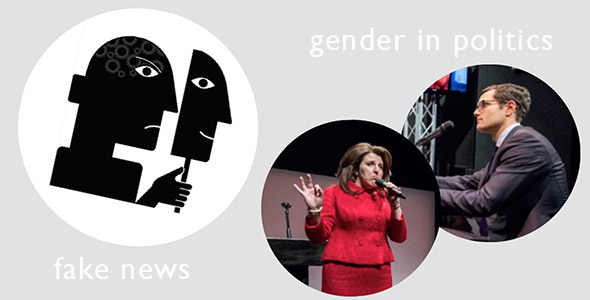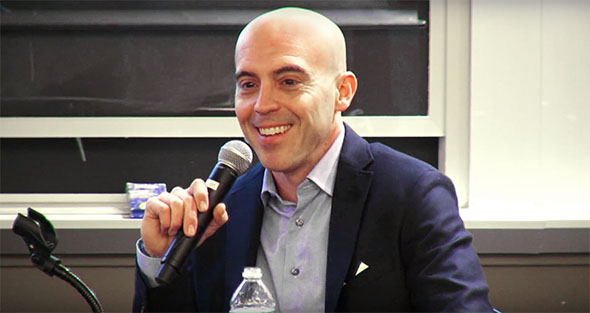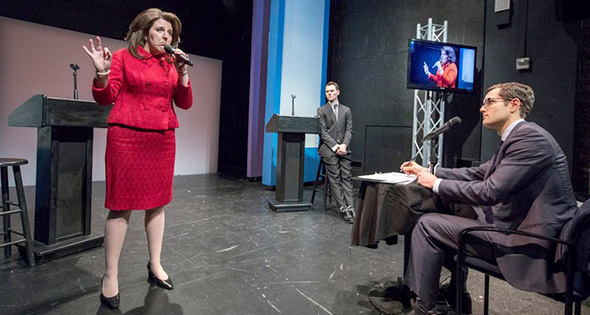MENS ET MANUS AMERICA SERIES
At spring events, MMA explores fake news and real gender issues

20 APRIL 2018
MIT’s Mens et Manus America (MMA) initiative shed light on two major issues on the political landscape — fake news and gender politics — during back-to-back events on April 17 and 18.
The April 18 event, “Fake News: Its Science and the Implications for Our Democracy, Politics, and Country,” drew a lively audience to E25-111 for a presentation and discussion of MIT research — published on the front page of Science on March 9 — that investigated the spread of true and false news online.
“The main result of the paper is essentially that false news diffuses farther, faster, and more broadly than truth in all categories—frequently by an order of magnitude,” said Sinan Aral, the David Austin Professor of Management at MIT Sloan.
The April 17 event, “How Does Gender Matter in Politics?,” drew a similar crowd to E62-276 the day before for a screening and discussion of Her Opponent, a play that re-creates scenes from the 2016 presidential debates, but with a male "Clinton" and a female "Trump." A key goal of the project, as co-creator Maria Guadalupe said, is to consider: “How would we judge the debate performances if the genders were reversed?”
Both events were sponsored by MMA, a nonpartisan MIT initiative focused on better understanding the country’s social, political, and economic challenges.
The Truth about Fake News

Sinan Aral speaking at the Truth about Fake News event; photo from event video
The researchers found that novelty is a key factor in the swift spread of fake news because novelty attracts human attention and because false news tends to be more novel than true news. “We used a rigorous way to measure," said Aral, "but we all know this. It’s just easier to be novel when you are making stuff up.”
Event video: The Truth about Fake News
How does it spread?
“Everyone is talking about fake news,” said Agustín Rayo, associate dean of the School of Humanities, Arts, and Social Sciences (SHASS), in introducing “Fake News” on April 18. “[This] research is amazing. … They actually worked out how it spreads.”
Aral, the David Austin Professor of Management at MIT Sloan, co-authored the Science paper with Soroush Vosoughi, a postdoc at the MIT Media Lab, and Deb Roy, an associate professor of media arts and sciences. Vosoughi was also on hand on April 18 to discuss the research.
According to Aral, who led off the evening with a short presentation, the MIT team began by collecting a corpus of true and false stories from independent fact-checking organizations. They then used records of Twitter posts from 2006 to 2017 to look for mentions of those stories and follow the paths stories took as they spread from person to person.
And why?
The researchers ultimately examined 125,000 rumors spread by about 3 million people over 4.5 million times. “We found false news was 70 percent more likely to be retweeted than the truth, on average,” Aral said. Once the researchers discovered the degree to which the spread of false news outpaces true news, they decided to try to learn why.
They found that novelty is a key factor because novelty attracts human attention and because false news tends to be more novel than true news. “[We used] a rigorous way to measure, but we all know this. It’s just easier to be novel when you are making stuff up,” Aral said.
The researchers also looked at how the use of web robots (aka “bots”) affects the spread of fake news. “Bots were accelerating the rate of false news, but they were accelerating true news at the same rate,” Aral said. “The conclusion from that, unfortunately for us, is that human beings are more responsible for the spread of false news online that we previously thought.”
There is a need for more transparency about the sources of online information. “When you go to the grocery store, food is extensively labeled. When you are consuming the news, you have no idea what you’re consuming.”
— Sinan Aral, David Austin Professor of Management
Potential solutions
Following Aral’s presentation, he and Vosoughi spent an hour and a half in an audience question-and-answer session moderated by Shamir Tonna, MBA 2018, a member of MMA’s planning committee. The discussion centered largely on what can be done about the spread of fake news.
One suggestion was for platforms such as Facebook to incorporate some measure of quality into their news feeds. “I think a lot more could be done by these platforms. They could make it easier for people to see the quality of information,” Vosoughi said.
Aral said there is a need for more transparency about the sources of online information. “When you go to the grocery store, [food is] extensively labeled,” he said. “When you are consuming the news, you have no idea what you’re consuming.”
However, both speakers noted that the idea of regulating or restricting what types of news are disseminated, or even which items get top billing raises serious concerns. “It’s a very difficult moral, ethical, and business question to determine what should go into an algorithm to determine what news should be promoted or demoted,” Aral said.
Vosoughi suggested one way to address the problem would be to educate consumers about “how to be deliberate when they read something to be sure they’re not spreading something that’s false.” He said his PhD thesis research centered on creating a system to detect unverified rumors as they were spreading—but emphasized that identifying falsehoods is just one piece of the puzzle. “What you do with that information is another thing.”
Ultimately, Aral stressed, there is a lot more work to be done. “There’s a whole landscape of potential solutions that need to be researched,” he said. “Souresh and I are both interested in what can we do about this.”
How does gender matter in politics?

L to R: Rachel Tuggle Whorton, Daryl Embry and Andy Wagner in “Her Opponent” at Provincetown Playhouse. Photo: Courtesy of Richard Termine
"Can experiencing what the two US presidential candidates said and how they said it during the three 2016 presidential debates — but through gender-reversed characters — cause people to revisit their own personal biases and develop insights or a different perspective?"
— Joe Salvatore, associate professor of educational theater, New York University; playwright and director
Video excerpt of the performance on CBS
“Fake News” followed another MMA event — “How Does Gender Matter in Politics?” — which began with a screening of a performance of Her Opponent, a 35-minute play first produced in 2017 at the off-Broadway Jerry Orbach Theater.
The play features a male actor playing Hillary Clinton and a female actor as Donald Trump reenacting segments from the 2016 presidential debates. The actors replay not only the words but also the gestures and speech cadences used by the candidates, so the performance highlights the role that body language, tone, manner — and ultimately gender — play in how people perceived the candidates.
The screening was followed by a discussion with the play’s creators — Guadalupe, an associate professor of economics and political science at INSEAD, and Joe Salvatore, a playwright and director who is also a clinical associate professor of educational theater at New York University.
Salvatore posed the question he said was asked before every performance of the play: “Can experiencing what the two US presidential candidates said and how they said it during the three 2016 presidential debates — but through gender-reversed characters — cause people to revisit their own personal biases and develop insights or a different perspective?”
What does this response tell us?
MIT audience members noted that the man playing Clinton appeared weaker than the actual Clinton had as he smiled through insults and ignored jabs by Trump. Trump as a female, in contrast, seemed more likable, and many said they felt it was easier to listen to what the actress was saying than it had been to listen to Trump.
Review of the full performance at The New York Times
Commentary on gender in politics by MIT philsopher Sally Haslanger
As CBS named it: "Debate and switch"
It was clear from the reaction of the MIT audience that the answer is “yes.” Audience members noted that the man playing Clinton appeared weaker than the actual Clinton had as he smiled through insults and ignored jabs by Trump. Trump as a female, in contrast, seemed more likable, and many said they felt it was easier to listen to what the actress was saying than it had been to listen to Trump.
“Hillary as a man came across softer than I would have expected,” said Barbara Dyer, a senior lecturer at MIT Sloan who attended the presentation.
Another audience member commented, “My experience is that women don’t interrupt other people speaking as much, so when [the woman playing Trump] did that, it was discordant.”
“I think men are more genuine to who they are in public spaces because they’re not second-guessing themselves,” another person remarked. “That’s a lesson to me as a woman — how thinking about how you present yourself can be damaging. Coming to a place of authenticity is important.”
Ezra Zuckerman Sivan, Siteman professor of strategy and entrepreneurship and deputy dean of MIT Sloan, who introduced the April 17 speakers, summed up his reaction to the screening this way: “I’m just blown away by the experience of seeing it,” he said. “I found myself paying more attention [to what each "candidate" was saying.]”
Guadalupe said she and Salvatore have found that the play tends to move audience members away from their preconceived notions. “We’ve seen self-identified Republicans liking Clinton more, and self-identified Democrats liking Trump more,” she said, noting that the play seems to encourage convergence — opening the door to discussion.
“It was refreshing to have people sit in the audience and talk to each other,” she said.
Suggested Links

About Mens et Manus America
The non-partisan Mens et Manus America Initiative explores social, political, and economic challenges currently facing the United States. The initiative is co-sponsored by the MIT School of Humanities, Arts, and Social Sciences and the MIT Sloan School of Management, and is co-directed by Agustín Rayo, professor of philosophy and associate dean of SHASS, and Ezra Zuckerman Sivan, Siteman professor of strategy and entrepreneurship and deputy dean of MIT Sloan. For information about the Mens et Manus America communications contact: SHASS Communications.
Suggested links
Video: The truth about fake news
Mens et Manus America Initiative
21st Century Citizenship | MIT SHASS Resources for Understanding and Engagement
Agustín Rayo
Professor of Philosophy, Associate Dean, MIT SHASS
Ezra Zuckerman Sivan
Deputy Dean, MIT Sloan School of Management
Commentary on gender in politics
Ford Professor of Philosophy Sally Haslanger
Previous Mens et Manus America events and stories
Mens et Manus America analyzes US immigration policy
Mens et Manus America examines the rural American economy
Economist Jim Poterba and accountant Michelle Hanlon discuss U.S. Tax Reform Issues
Jason Jay on How to Have Productive Conversations in a Polarized World
Adam Berinsky and Ezra Zuckerman-Sivan examine The Politics of Misinformation
Sociologist Arlie Hochschild discusses Finding Common Ground
Initiative launches with anthropologist Christine Walley's documentary film: Exit Zero
Story prepared by SHASS Communications
Editorial and Design Director: Emily Hiestand
Senior Writer: Kathryn O'Neill
Photographs from "Her Opponent," courtesy of Richard Termine